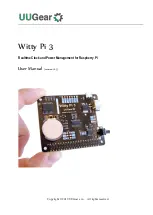
Masterclock
GMR
User
Manual
v2
–
2016.12
24
NETWORK
CONFIGURATION
The
network
configuration
may
be
viewed
in
summary
by
clicking
the
Network
Configuration
button.
Each
device
is
configured
with
a
device
name
from
the
factory.
Each
device
name
includes
the
model
name
and
a
MAC
address
extension.
You
should
change
the
device
name
to
one
that
can
identify
the
location
of
the
device.
By
default,
device
names
are
the
product
name
abbreviation
followed
by
the
last
bit
of
the
device’s
Ethernet
address
(MAC
address).
The
device
name
may
be
changed
from
the
factory
default
name
by
entering
a
unique
name
of
up
to
32
characters.
If
a
DHCP
server
is
available
on
the
network
when
the
GMR
is
installed,
the
unit
will
be
auto
‐
registered
with
the
DHCP
server.
The
network
system
administrator
can
then
view
this
DHCP
name
registration
and
the
currently
assigned
IP
address
at
the
DHCP
server.
The
GMR
allows
for
Static
IP
address,
Gateway
and
DNS,
network
configuration
entries
to
be
made
manually
if
no
DHCP
server
is
available.
In
addition,
the
NTP
server
addresses
can
be
adjusted
manually.
Manual
configuration
requires
disabling
the
DHCP
defaults.
To
use
a
3
rd
party
NTP
server,
the
DHCP
box
needs
to
be
unchecked.
INPUT
CONTROL
The
Input
Control
button
provides
access
to
the
Input
Control
window,
which
provides
buttons
for
NTP
Client,
Time
Code
Reader,
NMEA
Client,
NENA
Client,
and
GPS/GNSS.
INPUT
CONTROL
>
NTP
CLIENT
NTP
is
an
open
‐
standard
time
synchronization
protocol
designed
for
precision
synchronization
and
maintenance
of
time/date
on
computers
and
other
devices
attached
to
TCP/IP
networks.
NTP
itself
is
transported
with
the
UDP/IP
(User
Datagram
Protocol),
and
is
usually
served
on
port
123.
NTP
time/date
is
UTC
‐
referenced,
as
the
protocol
has
no
provisions
for
representing
Time
Zones
or
Daylight
Savings
Time
(“Summer
Time”
in
Europe).
A
wealth
of
useful
NTP
information
and
resources
can
be
found
at
http://www.ntp.org
The
GMR
acquires
its
internal
UTC
time
reference
from
an
NTP
timeserver
by
using
a
built
‐
in
NTP
client.
The
NTP
client
is
fully
configurable
and
can
operate
in
several
NTP
modes
to
reference
both
a
primary
and
a
secondary
NTP
server.
The
NTP
client
can
be
disabled
to
allow
operation
as
a
stand
‐
alone
unit
without
a
network
connection.
If
you
want
to
synchronize
PCs,
workstations
and
servers
to
your
GMR
you
must
run
an
NTP/SNTP
client
on
the
PC
that
receives
NTP
time
from
the
GMR.
This
client
is
responsible
for
asking
the
NTP
server
for
time/date
information.
In
some
cases,
it
simply
listens
on
the
network
for
NTP
time
broadcasts,
then
sets
the
internal
time
of
the
computer
or
device
Masterclock
provides
a
free
Simple
Network
Time
Protocol
(SNTP)
client
for
use
to
synchronize
PCs,
workstations
and
servers.
This
client
app
is
called
MasterSyncPC
Freeware
and
it
can
be
downloaded
from
the
Masterclock
website.
The
software
is
provided
as
‐
is,
as
a
courtesy
to
our
customers,
with
no
technical
support
provided.















































